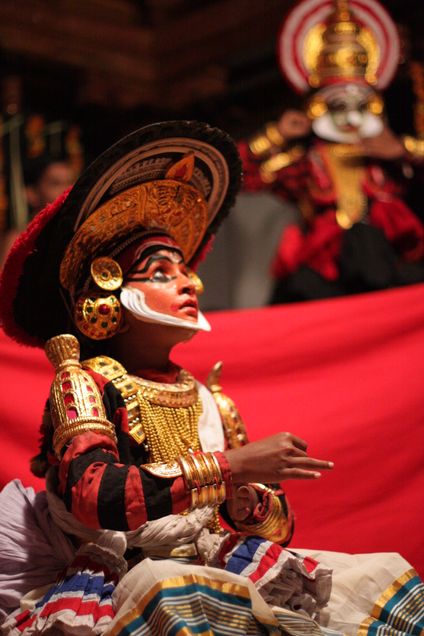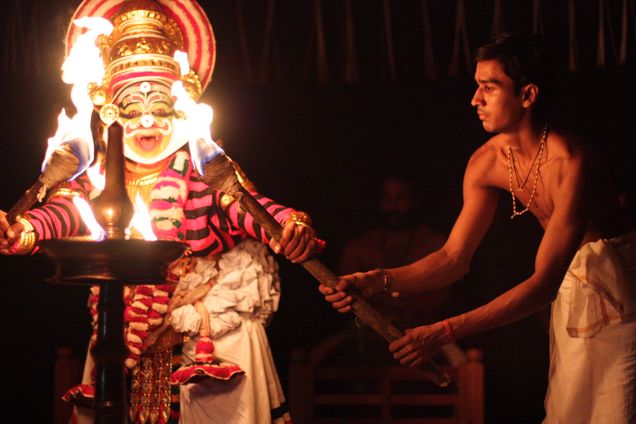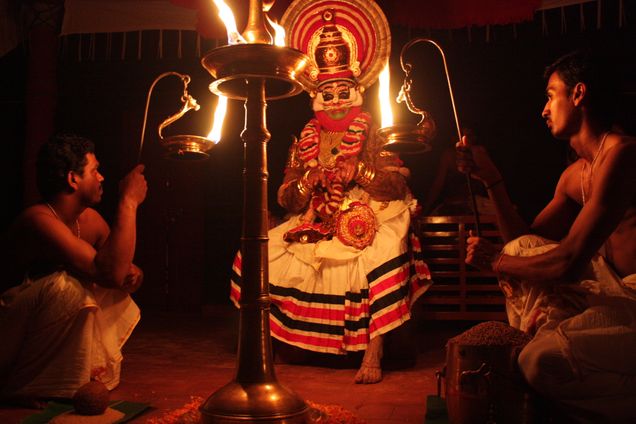Performing Sanskrit Scripture in Kerala, India
Monday, March 27, 5:30 PM: Leah Lowthorp and Finnian Moore Gerety, with Frank Korom, Moderator
Photonics Colloquium Room, Photonics Building, 9th Floor (8 St. Mary’s Street)
Reception to Follow at MeiMei Restaurant (506 Park Drive)
Lowthorp Workshop: Monday, March 27, 2:30-3:45 in Professor Kyna Hamill’s TH 102, Dramatic Literature course in the College of Fine Arts (members of the BU community are welcome to attend)
Kutiyattam(s) in Context: Complicating Rituality and Aesthetics in Sanskrit Theater
Leah Lowthorp holds a dual doctoral degree in Anthropology and Folklore & Folklife from the University of Pennsylvania and is currently a postdoctoral fellow in Folklore and Mythology at Harvard University. As part of her dissertation work on the impact of UNESCO recognition of Kūtiyāttam as an Intangible Cultural Heritage in Kerala, India, she was trained in the techniques and performance of the tradition. She has a unique ability to bridge the divide between “study of” and “participation in” this tradition, and in her lecture/demonstration she will share her perspective on “the ways artists emically conceive of rituality in relation to contemporary practice both inside and outside of the temple.”
performance of the tradition. She has a unique ability to bridge the divide between “study of” and “participation in” this tradition, and in her lecture/demonstration she will share her perspective on “the ways artists emically conceive of rituality in relation to contemporary practice both inside and outside of the temple.”
Kutiyattam(s) in Context Talk Description: Widely considered the oldest continuously performed theater in the world, Kutiyattam Sanskrit theater has been performed as a hereditary temple art by upper-caste men and women in Kerala since the eleventh or twelfth century C.E. Characterized by some as a “visual sacrifice”(chakshusha yajna), it was performed exclusively by hereditary performers within temple theaters until the mid-twentieth century. Following intense social and political upheavals in twentieth century Kerala, Kutiyattam performers and performance spaces were democratized, and it is now performed by hereditary and non-hereditary performers on temple and public stages throughout Kerala, India, and the wider world. This talk explores the impact of Kutiyattam’s democratization upon notions of rituality and aesthetics in performance. Based on nearly two years of ethnographic research among the Kutiyattam community in Kerala, India, it focuses on the ways in which Kutiyattam artists
twelfth century C.E. Characterized by some as a “visual sacrifice”(chakshusha yajna), it was performed exclusively by hereditary performers within temple theaters until the mid-twentieth century. Following intense social and political upheavals in twentieth century Kerala, Kutiyattam performers and performance spaces were democratized, and it is now performed by hereditary and non-hereditary performers on temple and public stages throughout Kerala, India, and the wider world. This talk explores the impact of Kutiyattam’s democratization upon notions of rituality and aesthetics in performance. Based on nearly two years of ethnographic research among the Kutiyattam community in Kerala, India, it focuses on the ways in which Kutiyattam artists emically conceive of rituality and aesthetics in relation to both past and contemporary practice. By examining the divergent ways in which artists contextually conceptualize these categories—temporally, spatially, and via repertoire—Dr. Lowthorp complicates the binary relationship between rituality and aesthetics that has been assumed in previous academic studies of Kutiyattam.
emically conceive of rituality and aesthetics in relation to both past and contemporary practice. By examining the divergent ways in which artists contextually conceptualize these categories—temporally, spatially, and via repertoire—Dr. Lowthorp complicates the binary relationship between rituality and aesthetics that has been assumed in previous academic studies of Kutiyattam.
Finnian M. Gerety holds a doctoral degree from the Department of South Asian Studies at Harvard University and is Visiting Assistant Professor of Religious Studies at Brown University. He works on ritual, text, and the senses in South Asian religions, with a focus on Hindu traditions of India. He has authored an article soon to appear in The Journal of Asian Ethnology entitled “Digital Guru: Embodiment, Technology, and the Transmission of Traditional Knowledge in Kerala,” which explores the manner in which the Nambudiri Brahmins of the South Indian state of Kerala transmit “what may be the oldest surviving musical culture in South Asia, a fixed oral tradition of sacred songs used in ritual (sāmaveda). Without recourse to written notation, Nambudiri practitioners teach songs face-to-face, using their voices and a distinctive system of hand gestures to convey melodies to their students.”
When Scripture Comes Alive Talk Description: While the Sanskrit scriptures of Hinduism, the Vedas, are widely available in manuscripts and books, many Hindus believe that the power of Vedic formulas (mantras) can only realized in performance, chanted aloud from memory by Brahmin priests. In Kerala, this authority is vested in lineages of Nambudiri Brahmins, who boast a tradition of Vedic transmission and performance going back many centuries. In this talk Dr. Gerety will focus on the aesthetics of Nambudiri performance, which are concerned above all with demonstrating mnemonic mastery over the mantras, liturgies, and rules that inform Vedic recitation and ritual. In this context, competence is predicated on precise chanting, posture, breath control, and ritual purity; to guard against mistakes, prompters guide the priests’ every gesture and utterance with cues and hand signals. In this aesthetic realm, faithful replication of traditional norms is paramount, personal expression is discouraged, and audience participation is tightly controlled. Members of the public are only invited to watch and listen from a distance, perform acts of worship directed towards the performance, and make cash donations. In this way, the aesthetics of memory foster the Nambudiris’ collective identity and regional reputation as living embodiments of Hindu scripture.
Dr. Lowthorp will also offer a workshop in Professor Kyna Hamill’s TH 102, Dramatic Literature course in the College of Fine Arts from 2:30-3:45 on the same day; members of the BU community are welcome to attend. Please contact us at scripart@bu.edu for further information.
Frank Korom is Professor of Religion and Anthropology at Boston University.
